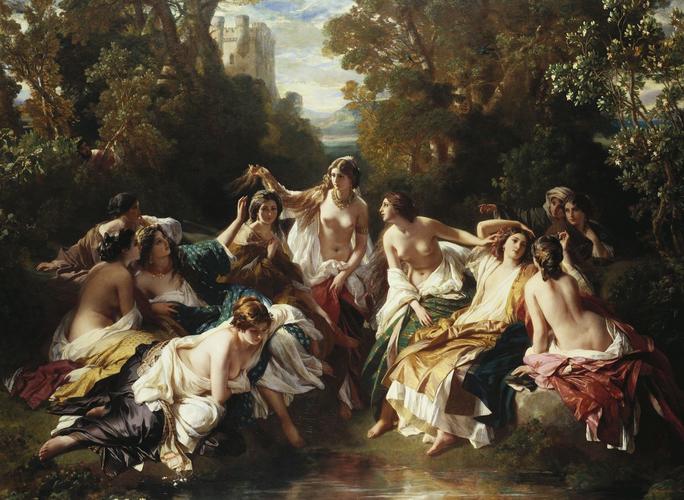-
1 of 253523 objects
Florinda Signed and dated 1852
Oil on canvas | 179.3 x 243.9 cm (support, canvas/panel/stretcher external) | RCIN 404860
-
The legend of the eighth-century Visigothic king Rodrigo of Hispania tells how Rodrigo’s seduction of the beautiful maiden Florinda ('La Cava') initiated the Arab conquest of Spain. In this scene Florinda (centre left) and her companions, all draped to varying degrees in luxurious Indian silks, prepare to bathe in the grounds of the castle near Toledo where she lives, unaware that they are being watched by King Rodrigo who hides in the bushes nearby. Rodrigo falls violently in love and seduces Florinda, to the anger of her father, Count Julian, who secretly meets with the Moors and encourages them to invade Spain. In the subsequent war Rodrigo is killed in battle by the invaders, who subject the country to their rule for two hundred years.
Winterhalter wrote in a letter dated 1869 that his inspiration for the painting was a sixteenth century Spanish ballad entitled La Cava, and his painting follows the text closely (Merwin, 1961). He might also have been aware of the Romantic treatments of the subject by English writers in the early years of the century, for example in the epic poems The Vision of Don Roderick by Sir Walter Scott in 1811 and Roderick, The Last of the Goths by Robert Southey (1814). Perhaps a more immediate inspiration was the staging of a new four-act opera by Sigismond Thalberg, Florinda, ou Les Maures en Espagne, which opened in July 1851 at Her Majesty’s Theatre during one of Winterhalter’s summer visits to England. Queen Victoria attended the opera during its opening month, and enjoyed seeing her singing instructor of twenty years, the celebrated bass Luigi Lablache (also the composer’s father-in-law), performing the role of Florinda’s father, Count Julian.
The Queen purchased the painting for Prince Albert in April 1852, writing that she had seen, ‘a most beautiful picture by Winterhalter, his favourite work, which I have purchased for Albert’s birthday, but which can be no secret, as it has to go to the Exhibition. It is a most lovely picture containing a group of beautiful women, ½ life size’ (Journal, 3 April, 1852). The painting was hung in the Queen’s Sitting Room at Osborne House, initially without a frame (Journal, 18 July, 1854).
Florinda was favourably received at the Royal Academy exhibition of 1852, where it was particularly admired for its colour and the beauty of the female figures. The critic of the Athenaeum wrote that ‘It is a picture of very great merit; the models are elegant and drawn with learned and decided outline…The colouring is gay – every possible tint is enlisted in the rich draperies. A warm light plays about everywhere; and the flesh glows’ (15 May, 1852, p.551). It was probably another signed version, now in the Metropolitan Museum of Art, New York, which was exhibited at the Paris Salon of 1853.
Historical genre painting was an unusual departure from Winterhalter’s typical court portraiture of the 1840s and 1850s. There is perhaps in its design a recollection of earlier depictions of the Ovidian scene of the bath of Diana observed by the hunter Actaeon. Winterhalter had used the arrangement of a circle of figures in a picturesque outdoor setting fifteen years earlier in his Decameron of c.1837 (Karlsruhe, Staatliche Kunsthalle). The artist clearly found the composition satisfactory, as it was to be reused, with the picturesque woodland setting, for his later group portrait, The Empress Eugenie surrounded by her Ladies-In-Waiting of 1855 (Compiègne, Musée national du château). The striking similarity between this later painting and Florinda, even to the extent of the position of the key figure, did not pass unnoticed and popular scandalous rumour suggested that the Empress and her ladies-in-waiting had modelled for the deshabillé figures in Florinda (in fact the Empress did not marry Emperor Napoleon III until 1853). One European princess however does appear to have been a model for the picture. In 1860 Queen Victoria wrote of the Princess Wittgenstein, ‘She still very handsome, having been a great beauty & her head painted by Winterhalter, appears in his “Florinda”’ (Journal, 12 October, 1860).
Signed and dated: Fr Winterhalter. Paris. 1852
Text adapted from Victoria & Albert: Art & Love, London, 2010Provenance
Purchased by Queen Victoria (£1,000 paid in two instalments of £500 on 1 July and 5 November 1852, QV Ledgers 1852/ 229-30); given to Prince Albert by Queen Victoria on his birthday, 26th August 1852 [Victoria & Albert: Art & Love, London, 2010, pg 460]
-
Creator(s)
Acquirer(s)
-
Medium and techniques
Oil on canvas
Measurements
179.3 x 243.9 cm (support, canvas/panel/stretcher external)
200.2 x 265.2 x 12.3 cm (frame, external)
Other number(s)
Alternative title(s)
Florinda: from Southey's "Don Roderick" Canto IX
